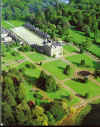Curraghmore House
by Orla Fitzgerald
Originally printed in "Waterford Today", April 18th 2000
The word Curraghmore comes from two Irish words meaning "great marsh".Two families claim the titles of Curraghmore House, one by direct descent, the Gurteen family; the other legal right, the Curraghmore family, or the de la Poer Beresfords. The descendants of the La Poher family, who accompanied Henry 11 in his invasion of Ireland, were the originators of the name in this country. Henry 11 made a grant of the "City of Waterford with all the circumjacent province" to Sir Robert La Poher who was the ancestor of the Waterford family. The eldest son of Sir Robert was Sir John de Poher, Baron of Donoyle and it seems the father built "Don Isle" castle, the Donoyle family being the parent stock of all the Waterford branches.
Curraghmore House
This is a very large photograph of Curraghmore House. It is a
beautiful picture and well worth the wait if you decide to view fully.
The Curraghmore line of the family originated with Roger, third son of the first Baron and it is he who is said to have built the ardent castle of "Curraghmore". A descendant of Roger, was Richard Poer, Lord of Curraghmore, who was Sheriff of the county and who died in 1493. His grandson, another Richard was the person from whom the grant title of Barony of Power and Curraghmore came. The first Lord of Curraghmore was married to Katherine Butler, a lady who was the daughter of Piers, 8th Earl of Ormonde, by his wife Margaret Fitzgerald, a celebrated character. Sir Richard, first Lord of Curraghmore was slain (according to English Annals) while on service for the Crown, by a traitor before 1538.
The line of Curraghmore House ended with Lady Katherine Beresford (nee Power), who married Sir Marcus Beresford. Through this marriage with Poer in the female line, her husband was created Earl of Tyrone in1746, but the inheritance of the title in the male line passed to the Gurteen family. Numerous were the houses and branches of this family besides those of Donoyle and Curraghmore. There were also Carrigaline, Corbenny, Faithlegg, Bellvue, Snowhill, Kilfane and Curragheen to name just a few. A history of Waterford would be incomplete without at least a brief outline of the descendants of this family.
There are many sources of interest to the visitor to this estate. The first and most notable object of interest is the little church of Clonegam. Clonegam is a parish and the public road from Ballyquin gate leads to the gate of the church, which stands inside on the grounds. The church was rebuilt in 1841. Considerable historic interest is attached to this spot and the inscriptions on some of the tombs are those of people who were highly respected and admired in their time. At the top of the church, is the splendid work of art raised to the memory of Sir Marcus Beresford, Earl of Tyrone, and Countess Katherine, by whose marriage the old baronies of Beresford and le Poer were united.
Another interesting monument on Curraghmore Estate is the Round Tower, which is situated on a hill and was built by the fist Marquis, George de la Poer Beresford to commemorate the death of his son in a riding accident. The view from the tower is picturesque and the inscription on the tower read "La Poer Tower, erected in the year 1785 by George, Earl of' Tyrone, to his beloved son, his niece and friend."
Curraghmore House is situated in the lovely valley of the Clodagh river, which enters at Lowry's Bridge and almost halves the land of Curraghmore. The half nearest Carrick-on-Suir is the portion which was originally in possession of the de la Poers. The section of land on the other side of the river, viz, the woods of Portlaw, Bayleck and Darrigal were obtained by purchase from the Duckett and Medlycott famlies. The area inside the boundary wall is 4,000 acres and outside is 3,000 acres, making a total of 7,000 acres of majestic, lofty hills, sumptuous vales and richly varied woods, which ennoble the natural magnificent and beauty of this ancient home of the Powers. At a distance, the mansion is imposing, being flanked on either side by rows of offices enclosing a court-yard and leading to the ancient castle front. The mansion was built by Earl James in 1700, but there is no record of the building of the ancient castle which is ascribed to Roger, third son of the first Baron, 1197. A spacious dwelling house was built at the rear of the ancient castle.
Anybody visiting Curraghmore estate must take a look at the Shell House. It is a grotto, made entirely of shells built by Lady Catherine Beresford. The patient work of completing the shell house lasted seven years, ending in 1651. Tourists to the area could also take a trip to the star fish shaped village of Portlaw. Even if one merely takes a Sunday stroll through the grounds of Curraghmore Estate, it should be noted that is a very historical location, worthy of closer attention.

